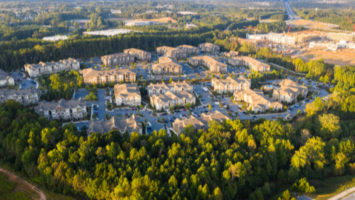
I recently had the privilege to speak with Jordan Finegan, a Smart Cities Consultant at Denver’s Office of Technology Services and Public Works, about Denver’s Living Lab and her role within the project. As a born-and-raised Denverite and someone with policy and public-private partnership experience, Jordan’s voice about smart growth has a unique tenor.
JF: I was raised in Denver, however, my career began in Washington D.C. where I worked for seven years at the U.S. Department of the Interior focused on public policy, public private partnerships, and politics. I decided to move back to Denver in July 2016 and was asked to begin working with the Office of Housing and Opportunities for People Everywhere (HOPE) as a communications consultant. I eventually joined the team as an on-call contractor focusing on program management.
HOPE was created by Mayor Michael B. Hancock with the intention of connecting housing, homelessness, and services throughout the city. Our office began collaborating with Denver Smart City on Living Lab Phase 2 around delivering safe and accessible transportation to vulnerable populations. I then joined the Denver Smart City team as a contractor in July 2018, bringing my housing and partnerships experience.
Today, my role is to support our business lead, Denver Human Services, while also acting as a liaison between the technical side of Denver Smart City and the service side with partners, such as the Denver Rescue Mission. I also bring in external partners who can assist us by providing data and connecting us to individuals from the community we can interview.
SCC: How did the concept for a living lab came to exist in Denver? What did Phase 1 entail?
JF: Denver Smart City has had the unique opportunity to install, understand, and evaluate several smart technologies in “living labs.” Our first living lab – Phase 1 – focuses on understanding the connecting vehicle technology in central Denver and is focused on six intersections around the Wellington Webb municipal building. Our focus with Phase 1 is on establishing a communication handshake between vehicles and infrastructure (V2I), specifically traffic signals.
To improve bicyclist safety, we are exploring technology that will enable cyclists to trigger a traffic signal when they are approaching an intersection. This technology and the data that is gathered will not only provide more awareness of people biking, but will also allow bicyclists to have an easier trip along designated routes. It is critical this is accomplished within an open source and open data environment.
SCC: Many people may not understand how a connection could be made between connecting vulnerable populations to social services and the concept of a smart city. How do those two efforts connect, and why was something so human-centric chosen for phase 2?
JF: The goal of our second living lab – Phase 2 – is to enhance mobility, improve safety, minimize negative environmental impact, and better connect our most vulnerable populations to affordable housing and services by identifying ladders of opportunities for the residents of Denver. We want to improve the quality of life for residents (whether they are vulnerable or not) through the integration of innovative technology and city services. Phase 2 is set in a half mile radius around Park Avenue and Lawrence Street, an area which has many land uses, and the goals include:
- Mobility – There are a significant number of pedestrian vehicle collisions and, through studying the data, we can develop technology that detects the presence of someone in the street and have the vehicle respond accordingly. Additionally, many who are homeless utilize services that are not near each other, therefore understanding common routes and movements will help in deploying more effective shared transportation services;
- Safety – This area has high rates of violence, drug abuse, and pedestrian/vehicle/bicycle collisions. Utilizing technology to address all these issues will help to protect vulnerable populations and elevate the shared experience of those who spend time in the area.
- Equity – We are working directly with homeless shelters to collect data and identify potential opportunities for partnership and more effective delivery of services to one of Denver’s most vulnerable populations
SCC: Where is Denver in the process of executing Phase 2, and what results have you seen so far?
JF: We are still in the foundation-building phase for Phase 2, so we have not begun measuring our results. We realized that one of the largest challenges with the Smart City Program in general would data collection and identified that a comprehensive solution would be needed to connect multiple systems and data from across the city departments, ultimately de-siloing the data. We have found common ground in understanding how strategic alignment and cross-collaboration not only benefit each organization but also helps the clients we are all serving. To support this effort, Denver became one of the first cities in the smart city space to build an enterprise data management (EDM) system. Our EDM system was built for integration (individual integrations) and interoperability (different data sources) and compiles real-time data on transportation, environmental health, weather, and freight. It drives smarter decision-making, emphasizing safety and security.
Currently, we are working with our partners and city departments collecting data. Partners include the homeless shelters within the Phase 2 target area, the city’s Denver Human Services, and the city’s Technology Services’ GIS team. Our primary goals are:
- to increase access to affordable transportation services;
- expand first/last mile transportation services; and
- reduce friction points in the area.
This data will inform these goals.
Furthermore, we have identified storytelling as a useful tool when working with the public. To build from human-centered design, we are partnering with a local cartoonist to illustrate the experience of utilizing social services in this area. We will distribute this story through several methods and hope that the storytelling resonates with the individuals who either live in the area or are passing through, finding recognition in the “other’s” experience. We are currently in the interview phase of that.
SCC: What challenges have you encountered along the way that you feel have impacted your understanding of the work?
JF: When I first joined this project, I had minimal experience working so directly with technology platforms. There was a very steep learning curve, and I still find myself asking basic questions when necessary. What I bring to the project is my experience working with partners, having a knowledge of the vulnerable population’s experience, and thinking through situations from a public policy lens, as opposed to a technology lens. However, despite this initially being a challenge, I have found value in meshing my misunderstanding in one area and my expertise in the other, as I am someone who can think outside of the box in certain situations and ask the question that would have eventually been asked by someone at a policy level.
SCC: If another community wanted to replicate what you’ve done here, how would you advise them to begin?
JF: Talk to your agency partners and understand what their pain points are. These can turn into use cases, which will inform the right processes and technology to deliver value directly to all those who live in your city or town.
SCC: What has made Denver a unique place (and perhaps a unique time) to tackle this project?
JF: Denver has increased by 100,000 people in the last seven years. Today, Denver has one of the strongest local economies in the nation; and our priority is ensuring that this prosperity extends to all residents. The Smart City Program utilizes Denver’s progressive approach to innovation which is rooted in its pioneering, western spirit.
SCC: The Smart Cities Connect Conference and Expo will take place in Denver next April 1-4. What do you hope attendees might know or experience about Denver’s smart vision at that time?
JF: I hope attendees get a clear sense of how we are working to contribute to emerging industry and looking to deliver value directly to our residents. We are finding unique ways to engage with our residents and hope the direct relationship between our efforts and their value is seen through our work around supporting vulnerable populations.


